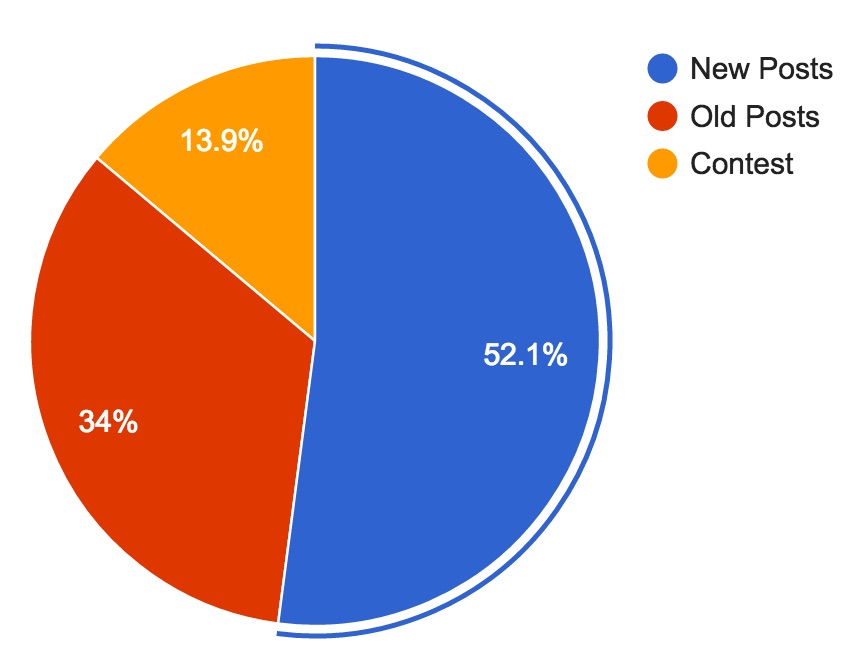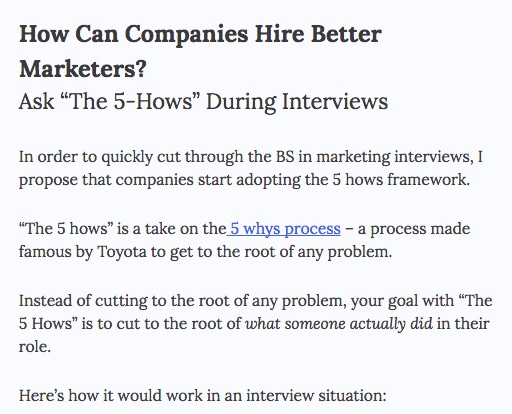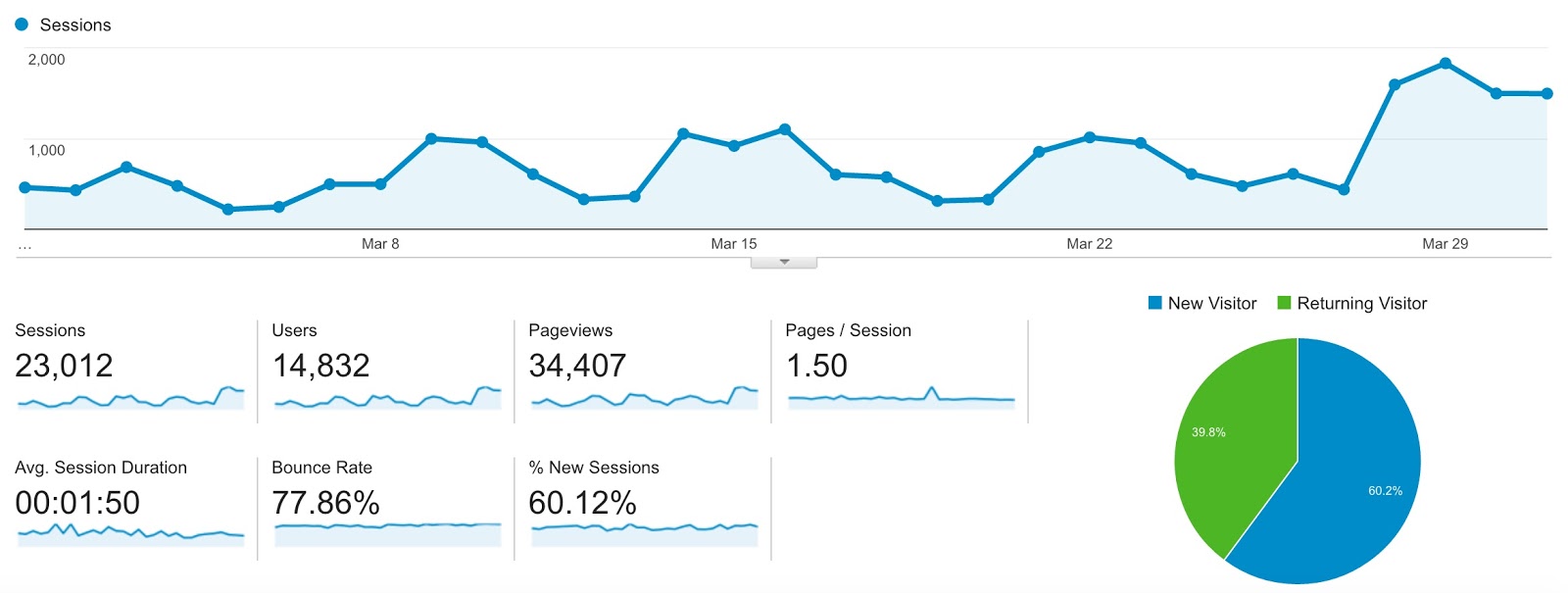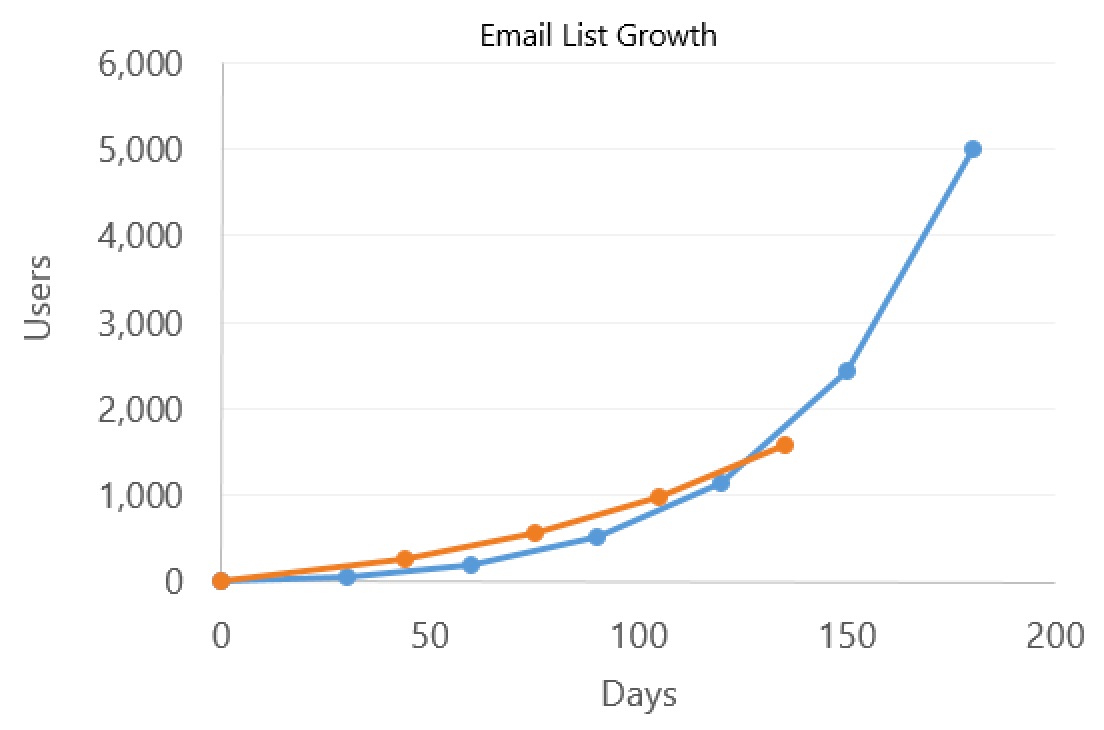At the beginning of March we built a growth model for traffic to this site.
The point of the growth model was to turn traffic estimations from a hopes and dreams model, to a predictable calculation.
To do this, we built a bottoms up growth model.
That means, instead of a top-down model that says “we got 10,000 uniques last month, and we want to grow by 25% every month, so this month we’re estimating we’ll get 12,500 uniques.”
We said, let’s list all actions we can control, like:
- How many posts we write
- How many guest posts we accept
- How many other traffic generating campaigns we run
…and multiply those numbers by the amount of traffic each action has produced in the past.
That made it bottoms up (relying on actions we can control), and data driven (using previous data).
Here’s what this model looked like for March:

Not too complicated.
For a full breakdown of this model, see Part 1 of this series, where I walk through it step by step. Or get the spreadsheet for yourself for free here.
In short, our actions-we-can-control were:
- Posts written on our site
- A contest
We multiplied those actions by estimates of how much traffic each would produce and figured out how many posts we’d need to get to 20,000 users in March (3 posts a week).
In this post we’re going to go over what actually happened in March, compare each step with what we modeled and discuss how well the model worked and what this means for the future of Grow and Convert.
Let’s jump in.
Model vs. Actual: Posts On Our Site
Existing readers know that the majority of our traffic so far has come from community-based promotion of posts on our site — not guest posts on other sites, not SEO, not social shares, just posts on our site heavily promoted in marketing communities and groups.
In our March model, we planned on doubling down on this, and forecasted 52% of March’s traffic coming from new posts we planned to publish in the month (with the remaining coming from baseline traffic from old posts and a social contest).

That “new post traffic” was forecasted to hit 18,750 unique pageviews coming from 12 posts averaging 1,563 unique pageviews each.
How did we actually do in March?
We only published 7 posts, slightly over half of what we had planned. But, instead of the posts giving us 1500 unique pageviews each, they averaged 2,400 unique pageviews each.
Hooray.
How many posts per week was reasonable for us? Hint: Not 3.
Not producing as many posts as we planned was predictable — 3 a week is aggressive considering what we define as a post (2,500+ word case studies or how tos). So we learned that “pushing hard” for us meant 2 posts each for Benji and me in a month, and 3 guest posts.
We’re not too worried about not hitting 12 posts a month.
We both agreed early in March that it was better to not hit that number and talk about why in this post than produce lower quality posts just to hit it, which has obvious negative long term consequences.
How much traffic did each post produce?
This was the most incredible thing about March.
We had predicted 1500 unique pageviews per post. With posts published at the beginning of the month producing 2500 unique pageviews in 4 weeks and posts published later in the month producing a proportionally reduced amount in March:

That makes sense right? You’d expect a post published in the last week of the month to not bring in the same traffic within that month as a post published at the beginning.
This is what actually happened:

Clearly, there’s not a lot of correlation to the linear reduction in the model.
The three posts in Week 1 averaged 2880 unique pageviews. That’s spot on (actually slightly higher) than the modeled traffic for posts published in the first week.
Week 2 was also very close to predicted.
But two posts in the second half of March got way more traffic than we predicted a post published that late in the month could accumulate by month’s end.
Let’s look into both of those surprising posts in detail to understand why.
Surprising Post #1: Free Facebook Ads

In Week 3, I published a case study of a relatively young business that discovered a method of getting steady leads from Facebook ads that were “self-funded” via a mini-product that more than covered the cost of the ads.
It was published on March 22 but still managed to get 2,444 unique pageviews in the 9 days left in March. This is incredible. Our data suggested an average post on our site will get 2500 unique pageviews in its first 4 weeks.
Clearly, this post was not average.
Here’s where traffic came from:

The majority came from Growth Hackers where it did really well and made it into their weekly email:

Lesson: If you can tap into a community with an existing large audience, you can get loads of traffic quickly (in particular if you make it onto a popular email list).
Surprising Post #2: Marketing is the Hardest Position to Hire For

Then, on March 28, instead of just letting me have my glory with the over-achieving post, Benji — that punk — decided to one up me with his opinion piece on Why Marketing Has Become The Hardest Position to Hire For.
This post brought in a whopping 2,542 unique pageviews in three days. GTFO Benji.
Unlike the Facebook ads post, this one had traffic from a variety of sources, with the leader being Inbound.org, because it sparked a lot of discussion there:

From Benji: What I did to promote this post
Initial traction with this post kicked off when I posted it on Inbound. Within a few days time, It garnered 40 comments and 151 votes.

The next thing I did was post it to the Digital Marketers group on LinkedIn

It definitely stirred some debate with 10 comments, which in turn caused it to get pushed through peoples LinkedIn feed.
Then I also shared to some marketing related FB groups and after that, the post pretty much took on a life of it’s own and was shared by many business owners and marketers by e-mail and social.
Back to Devesh…
Finally, if you’re curious how much traffic these two over-achievers produced since the end of March, don’t worry, I was curious too. Free Facebook Ads has tallied 3,362 in 30 days and Hiring Marketers has hauled in a whopping 6,338 unique pageviews in 30 days.

Considering our model assumed 2500 unique pageviews in 4 weeks, those are stellar numbers.
Opinion: What’s Special About These Two Over-achieving Posts?
I’d like to temporarily break from my mathematical breakdown of March to wax poetic about these two posts.
First, their differences.
What I actually like most about these two overachieving posts is how very different they are: One is a case study and the other is a semi-controversial opinion piece.
Now, you can write off the case study as just that, a case study that happened to do well. It’s a content framework that has been around longer than the internet and we think it’s still one of the most powerful content frameworks your business can use in its content marketing. It inherently carries detail and social proof which builds both trust and desire in prospective customers. That’s why our entire site to date has been case study based.
But, what about Benji’s piece on hiring marketers?
It goes against the common marketing blog post trend of “how to” or “case study”. It’s an opinion piece…that can’t be that valuable right?
Wrong.
I noticed two subtleties about the hiring marketers post that I think helped it do incredibly well.
First, yes, it is an opinion piece, and thus it stood out from the crowd for our audience.
I’m arguing that a well thought out opinion piece can add more value than the same old “how to” your audience has seen 100 times.
The title was intentionally provocative, without over promising (we didn’t bait-and-switch, we honestly spend the entire post defending the assertion in the title).
Second, it actually has a how-to section baked into the opinion.
Unlike a typical ranty opinion piece that’s mostly entertainment and witty sarcasm that you’d find on, say, Medium, the hiring marketers post had serious doses of practical, usable strategies. For example, Benji presented the “5 Hows” technique for filtering marketer candidates that a hiring manager or CEO could use immediately on their next interview.

Multiple people commented on this (42 comments in total):


Third, it agreed with an opinion that our target audience already had.
This is a subtle technique I learned from working with Brian Dean. People love sharing things that reinforce their existing opinions.
Or said in another way, a controversy has two sides, people who disagree and people who agree. You only need one for a piece to take off.
We were actually hoping this post would piss off developers and thus get a bunch of attention in that community but it didn’t. Perhaps because they just didn’t care, or because we don’t know how to promote in developer communities.
But it didn’t matter. Marketers far and wide loved it.


Are we (and they) right? Is marketing actually the hardest position to hire for? The truth is, it doesn’t matter. All that matter is our target audience (marketers, CMOs, founders of startups) agrees with it — not in a “I’ll nod my head” way, but in a “OMG, yes I’ve felt this pain of hiring, let me rant about my story!” kind of way. You can look at all of the comments to see.
Takeaways from New Posts in March
We learned a few things from comparing actual vs. modeled traffic for new posts in March.
First, it’s okay to compromise post quantity for quality. The two overachieving posts at the end of the month did a good job making up for the large hole left by publishing only 7 of the 12 posts we had planned on for the month.
Second, explore different content frameworks instead of just sticking to the same thing. Opinions are good to sprinkle in to your usual diet of “utility” posts — and it’s even better if you they have substance and controversy.
Even if your company is in a “boring” space, think carefully about opinion pieces that can get your company some attention. Here are some examples.
The employee scheduling app company When I Work has a thriving blog that discusses issues that small businesses have. Now, they make an app to help small business owners schedule hourly employees: not the most controversial or click-inducing topic, right?
But look at who ranks #1 on Google for “pros and cons of minimum wage”:

It’s a topic that their audience thinks about and it’s controversial: you’re damn right people have strong opinions on both sides.
Here are more examples to get your gears churning:
- Company: Web development agency. Opinion Piece: Why Flat Design is Not a Good Idea
- Company: Women’s apparel ecommerce. Opinion Piece: Stop wearing black because you think it’s slimming.
- Company: Real estate firm. Opinion Piece: Why the housing price drop is actually good for you.
I’m just making these up, but you get the picture. Think creatively. Come up with 10 ideas, discuss them at the office, and write about the one that gets the most heated discussion going.
Other Traffic: Baseline and (a non-existent) Contest
Besides new posts, we modeled two other sources of traffic.
- Baseline traffic – a combination of referral, SEO, and other sources of traffic to posts published before March. We used February’s baseline traffic as a data-backed benchmark for March.
- A social contest – traffic from a giveaway that we planned to do in March where users would get more entries in the contest by sharing with friends or on social media. We hadn’t done this before so we guestimated based on other people’s reported results.
Baseline Traffic: Spot On
Our actual baseline traffic was spot on. We modeled 12.3k of and got 12.6k. Our modeled number was identical to baseline traffic in February, which in this case was a decent assumption because we didn’t publish much in February.
Be careful when you do this yourself, if you have steadily growing SEO traffic or have a good month like we did in March, your baseline traffic will expectedly increase (because you’ll have more posts providing more traffic). You should be able to use a trend of how much this has increased over the past few months to predict next month, however.
Social Contest: Nope. How about an app instead?
We didn’t do a social contest. I know, I know, how lazy of us. If it helps, we instead stumbled into a great idea for a content publishing app we’re calling Postable.

So, we were busy working on it behind the scenes in March. We’d love it if you’d go check it out and save yourself hours of time wasted in WordPress formatting.
We figure this was a decent compromise as Postable has some great long term potential both in terms of revenue and overall brand building.
Overall: How Useful Was the Model?
We loved having the model in March, and here’s why.
Instead of just setting out an aggressive goal like “we want 20,000 users this month” and hoping and praying, we were able to see exactly what we did that helped and why we didn’t hit our goal.
Here’s a summary of how we performed on all the key metrics.

From this summary plot, it’s pretty clear why we didn’t hit our Total Users goal: Number of Posts.
We’re totally okay with this result. As we said earlier, we have no desire to sacrifice post quality for quantity.
The second thing we noticed is that we got way more unique pageviews per post than we predicted. That’s great. Is it predictable? Will it happen next month? We can’t answer that with certainty, but this is super useful for two reasons:
- We know what’s possible. Averaging 2500 uniques per post in a month is high. And some of these posts got over 3000. We know these are high numbers, and they won’t happen for ever post, but we know it can happen, and we know what we did for the posts this month to make it happen. That knowledge is valuable.
- We can further refine our estimate. Even if 2500 unique pageviews per post is not sustainable every month, in future months, we can start creeping our estimate up from 1500 and seeing how we perform. Over time, we’ll start to hone in on what’s sustainable long term.
So in the end we have a better sense of how much traffic each post brings in, and we know how many posts a month we can reasonably produce, and a model that tells us how much traffic we can expect from those efforts.
Now, instead of hoping and praying, we can predict how much traffic we’ll get each month.
We consider this quite the success.
March Stats Recap + Our Plan for Moving Forward
Traffic: 95% month over month growth
Here are our traffic stats for March, just like we’ve done for February, January, December, and November.
Total traffic:

Note the huge spike at the end from Benji’s massive promotional push on his hiring marketers piece.
I salute you for your effort:

Our traffic in March versus February:

Users (what Google used to call “unique visitors”, or what people casually refer to as “uniques”) has been our key metric from the beginning, and a 95% increase from one month to another is satisfying.
Here’s where we are on our 6 month graph:

Still spot on! (But that will change in April, as we discuss below.)
SEO “indicators” like impressions continue to increase:

But we haven’t yet broken through to the first page on critical keywords, so actual organic traffic is increasing, but is still at the early part of the “exponential” graph, so we’re only starting to touch 1,000 sessions a month from SEO:

In order to get significant, sustainable traffic, we’ll need SEO traffic, as we discuss below. To date, we haven’t done any real “link building” outreach. All links have been built organically by people finding our material and linking to it on their own.
List Building: 60% growth
We reached 1580 email subscribers in March which is 60% growth from the previous month.

Our list growth hasn’t been spectacular, and here’s why:

Many posts aren’t converting well because we’re being lazy and not including content upgrades.
Note: In previous recaps, we had reported 7%+ conversion rates. That was a mistake. It turns out we were using “all goals” in GA, but one of the goals was already measuring visits to all thank you pages, so it was double counting. We humbly ask for your forgiveness.
It’s an ongoing battle between “focus on one goal” (traffic) and “always build the list”, which is critical for an information and education based site like ours.
This needs to change and will become part of our new strategy starting in April. Let’s talk about that next.
Our New Focus: SEO and List Building
Building the traffic model, executing the plan (as best as we could), and comparing results in March has taught us a lot about what is possible.
So has the entire last 5 months of this project.
We’ve grown traffic to over 20,000 sessions and 15,000 users in a month primarily through community based promotion:
- Find out where your target audience hangs out
- Make unique stand out content on topics of interest to them
- Promote in those communities
- Use one on one relationships you build in those communities to further promote
This has worked well, but, it won’t be enough to get us to 40,000 users/month.
We’re not leaving that goal behind, we’re going to hit it, but it won’t be in the 6 month timeframe that we originally hoped for. We’ll also continue to do monthly updates.
SEO: Intentional Link Building
We need SEO traffic to get us to the 40,000 unique visitor number. We don’t see the point in just publishing more and more just to hit that number.
Plus with community based promotion, you can easily wear out your welcome by over promoting your own material. Even Neil Patel on his $100,000 challenge isn’t hitting 40,000 users in 11 months without SEO.
It takes time to build domain authority (and thus rank more easily) on a brand new domain (ours is at 29 now, according to Moz), and we’re happy to wait until that happens.
So, we’re going to begin focusing on list building tactics. Things like broken link building and the Skyscraper Technique.
We’re not sure if it will work or if it’s better to just keep promoting in communities, but we’ll give it a shot and let you know how it goes.
Conversions: Building the Email List
We also think it’s time to start really focusing on converting more visitors into subscribers. Like I mentioned above, many posts aren’t converting well because we just don’t have calls to action on them.
Now we have enough traffic to change that — we’ll start creating content upgrades and perhaps even optimize our homepage to be more of a welcome gate.
We know that as we start to roll out more products and services, the email list will be essential for early customers, and at 15,000 uniques a month, the difference between 3% and 10% conversion rate adds up fast.
Questions about our change in strategy or what the future holds for us? Ask us in the comments.
Also if you have specific experience with manual or intentional link building, let us know in the comments.
Want us to write an in depth case study or story like this about you or your company? We’ll also drive traffic to it. Apply here.
Like this article? We produce stories like these for our clients, learn more here.
Get the Growth Model
Where should we send the link?
We'll send it by email and add you to our free newsletter, where we send in depth content marketing articles (like this one) as well as exclusive email-only ideas about once a week. It's free and you can unsubscribe at any time.








